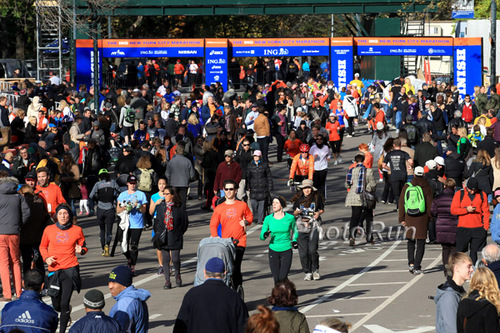Marathon Mourning In America
NYC Mayor And NYRR Leadership Deserve Support
Nobody
wanted it to be this way. Everyone wanted New York’s first Sunday in
November to be as it always is: a glorious, bracing fall day, the
city’s harbor filled with water-spurting tugboats, and tens of thousands
of runners eagerly poised to explode over the Verrazano-Narrows Bridge
to begin a five-borough odyssey to the Central Park finish line. But the
meteorological gods had other plans.
Less than a week before the
New York City Marathon’s race day, Hurricane Sandy — or “The
Frankenstorm” as it came to be known — unleashed a furious attack on
the East Coast.  Although
Although
the approaching storm was widely broadcast and the inhabitants and the
safety forces of the eastern seaboard were provided ample time to
prepare and — in some cases — to vacate, few were able to withstand
the actual ferocity of the hurricane-force winds and relentless lashing
rains that Sandy delivered to the New Jersey Shore line and the greater
metropolitan New York area.
As Sandy uncorked its fury, New
Yorkers did what New Yorkers always do — they dug in their heels and
toughed it out. Two days later, as the storm blew beyond the city and
later tapered off, city inhabitants and its elected leadership made
preliminary post-storm assessments. The devastation was horrific, to be
sure: power outages plagued millions; storm surges of record magnitude
wreaked havoc, crippling homes, businesses, and entire neighborhoods;
and inner-city transportation was rendered chaotic or inoperable.
Early
in race week, Mayor Michael Bloomberg, New York’s stoic, indefatigable
leader, was eager to move the city forward, beyond the immediate
aftermath of Sandy. He and the New York Road Runner Club envisioned the
upcoming New York City Marathon as a way to demonstrate the fortitude
of City’s inhabitants and to galvanize the community with an event that
annually promotes unity, cultivates civic pride, and offers to the world
an inside glimpse of the heartiness of its citizenry and the resiliency
of this special city. The Marathon, the Mayor announced, would go on
as planned.
Initial reaction to the Mayor’s bold proclamation was
generally met with admiration. Early voices endorsed the notion that
the City would rise above the weather-induced calamity, spit in the eye
of this setback, and demonstrate to the community and the world that New
York can take an enormous punch and come back strong. Many likened such
an approach to the running of the 2001 NYC Marathon — which took place
less than two months after the 9/11 attacks. References were even made
to the 1972 Olympics — when the marathon was run in Munich only days
after 11 Israeli athletes and coaches were killed in a terrorist attack.
But
as race week in New York progressed, more detailed information about
Sandy’s devastation emerged: the hurricane damage was more extensive
than originally thought; the timeframes for the anticipated resumption
of an array of city services lengthened; the scope of resident suffering
was revealed to be more serious and more widespread; and the magnitude
of the type of realistic and effective overall relief effort that would
be needed was approaching overwhelming proportions. Suddenly, the
concept of running the New York City Marathon as a sort of glorious
symbol of the city’s indomitable spirit and its triumph over adversity
— viewed as a noble undertaking just days before — was subject to
rightful questioning. And that questioning soon ignited an impassioned
conversation — on social media and elsewhere — of the pros and cons of
staging the race.
The City and the NYRR found itself in
uncharted waters, unable to draw upon past experience within the sport
to help guide it in making an appropriate decision in this unprecedented
circumstance. As the hours before race day were melting away, and as
the chorus of influential voices on both sides grew larger and louder,
Mary Wittenberg, President and CEO of the NYRR, announced late Friday
that the race would not be held, would not be postponed — it would be
cancelled. In acknowledging the fevered pitch taken on by the raging
debate, the NYRR posted a statement on its website that explained that
“Neither the NYRR nor the City could allow a controversy over the
Marathon to result in a dangerous situation or to distract attention
from all of the critically important work that is being done to help New
York City recover from the storm.”
Anger, relief,
disappointment, frustration, sadness, and vindication are but some of
the emotions evoked by Friday’s announcement. All are understandable
reactions to the cancellation. But, in the end, it must be appreciated
that the City and the NYRR were placed in a very difficult and
unprecedented situation and were called upon to make an extremely
critical decision that would have implications beyond the parameters of
the race itself. It is tough — and perhaps impossible — to quarrel
with the decision to cancel the race, to eliminate distraction from the
relief effort, and to quell an unnecessary controversy. To place the
accelerated relief effort to aid more than 2 million people in distress
ahead of a sporting event hosting 47,000 runners in the same devastated
city seems like the appropriate ordering of priorities.
The
opportunity for unbridled expression in this country is a valued,
time-honored and protected right. And while everyone is entitled to his
or her own view of this complicated, multi-faceted situation, the Mayor
and the NYRR have earned the right to be given the benefit of the doubt,
to be accorded a certain deference in the judgment they were called
upon to exercise under trying and unprecedented conditions.
It
would appear that a presumption of good faith to which both the City and
the NYRR are rightfully entitled would not currently appear to be
misplaced. Race leadership has lost little time in transforming what
could easily have been viewed as an overwhelming disappointment for the
organization into a unique opportunity to redeploy its considerable
influence, organization and resources in a way that can aid storm
recovery in a significant way. The NYC Marathon website already invites
its runners — indeed all of its visitors — to support the “Race To
Recover” Relief Effort by supplying clear directions on how to make
text-driven contributions.
A humanitarian act like this from the
NYRR — assembled and promoted even in the midst of the frenzied race
cancellation weekend — represents a positive first step. But as would
be expected and as the NYRR likely knows and understands, more proactive
initiatives will need to be forthcoming in the days and weeks ahead. It
is true that the race cancellation as a result of Sandy’s wrath will
undoubtedly cause the NYRR to endure significant unanticipated economic
consequences and sustain large unplanned expenses. But those unbudgeted
costs, not likely subject to current quantification, will be offset in
some measure by certain cost-savings arising from the race cancellation.
And so the race organization must challenge itself — in much the same
way it expects it marathoners to challenge themselves on race day — to
do even more. Additional initiatives — such as redirecting additional
amounts of its own revenues to the relief effort or developing and
implementing a procedure that would allow disappointed 2012 entrants to
gain prompt and assured entry into the 2013 race while receiving some
sort of discount or refund, a portion of which runners could elect to
direct to the relief effort — would be welcomed further action. Such
overt steps would also further signify that the trust and support they
seek and likely will receive — from the marathoners in particular and
the greater community in general — has not been misplaced.
Deeper
thought into the consequences of the cancellation suggest that many
matters yet to emerge will have to be addressed: legal and public
relations issues surrounding entry fee forfeiture under circumstances
where event participation is precluded due to no fault of the athlete;
appearance fees for elite athletes; “claims” elite athletes may assert
regarding lost revenue opportunities; and “claims” by all sorts of
entities that provide funding for the event, from high-profile sponsors
to fee-paying expo vendors — to name a few.
The City of New
York and the NYRR will be left to sort out all of the consequences of
Hurricane Sandy and the subsequent race cancellation. As we look back on
the events that have occurred and the actions that have been taken
since Sandy bombarded the East Coast, those of us who love the sport
will have plenty of opportunities — and the benefit of perspective —
to judge and to comment upon the decisions that leaders had to make in
real time. It is often said — and with justification — that hindsight
is 20/20. But in this situation, that sort of retrospective vision will
likely prove to be most useful if viewed through the lens of tolerance
and understanding.
~Dave Hunter
Author

Larry Eder has had a 52-year involvement in the sport of athletics. Larry has experienced the sport as an athlete, coach, magazine publisher, and now, journalist and blogger. His first article, on Don Bowden, America's first sub-4 minute miler, was published in RW in 1983. Larry has published several magazines on athletics, from American Athletics to the U.S. version of Spikes magazine. He currently manages the content and marketing development of the RunningNetwork, The Shoe Addicts, and RunBlogRun. Of RunBlogRun, his daily pilgrimage with the sport, Larry says: "I have to admit, I love traveling to far away meets, writing about the sport I love, and the athletes I respect, for my readers at runblogrun.com, the most of anything I have ever done, except, maybe running itself." Also does some updates for BBC Sports at key events, which he truly enjoys. Theme song: Greg Allman, " I'm no Angel."
View all posts




















